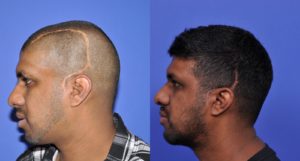What Is Skull Reconstruction?

Skull reconstruction involves restoring not just the bone defect but also muscle, fat and skin defects to establish a more normal structure and appearance. The skull deformity or defect can be due to tumor, trauma or infection. Typically, patients are seen after emergency neurosurgery is performed to save a person’s life. In these situations, resolution of the life-threatening issue takes priority over reconstruction.
Dr. Eric Payne is a craniofacial plastic surgeon who is trained in skull reconstruction for skull deformities after neurosurgical intervention. The goals of craniofacial reconstruction are to establish normal function of the skull in appearance with lower risk of complications. One area of interest is in establishing normal bone contour. This can be done with several methods such as bone graft, bone substitute and custom implants. Bone grafts can be taken from the patient’s skull or hipbone (iliac crest). If indicated, bone graft substitute, such as calcium carbonate hydroxyapatite granules, can be used for smaller skull contour deformities. The body will incorporate the hydroxyapatite into new bone forming around the defect. For very large skull defects, a custom-made skull implant can be created and placed directly over the brain for protection and reconstruction of the skull. Typically, these implants are made out of synthetic material. It is recommended to use 3D CT skull scans to help create the custom implant.
Dr. Payne works closely with the neurosurgeon involved to create the implant to achieve the best functional and aesthetic appearance. By working together, the number of surgeries can be reduced and complication risks minimized.
Cranial soft tissue defects can be reconstructed with several different options, such as fat grafting and vascularized free tissue transfer, to restore volume to the face and, more commonly, the temporal hollowing that occurs. The temporal area is located behind the orbit (eye socket) on the side of the skull just above the ear. The temporalis muscle, which pulls on the mandible to close the mouth, is typically detached during emergency neurosurgery and retracts over time, causing bulging over the cheekbones. This can be seen as fullness just in front of the ear and hollowing or depression just above the bulging along the temporal area of the skull. The extent of the deformity will determine the type of technique used to reconstruct the temporal hollowing.
Some people request fat grafting; however, this is not ideal for large defects or over an implant. Creating a customized silicone implant to simulate the temporalis muscle is possible. Sometimes these implants may need to be changed out in the future, requiring another operation. If a custom skull implant has already been inserted, then vascularized tissue is the best option in these cases, as it will prevent future infection and complications. Vascularized free soft tissue transfer can be harvested from the thigh or back then blood vessels reconnected using a microscope to help reconstruct the soft tissue covering the skull deformity and or implant.
Please call us a call to schedule an appointment for skull deformity reconstruction with Dr. Payne. He’ll be happy to answer any questions and come up with the best plan for your situation.

